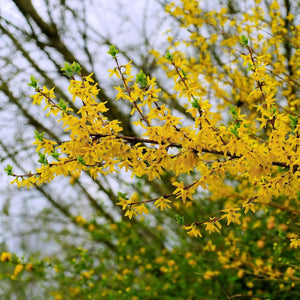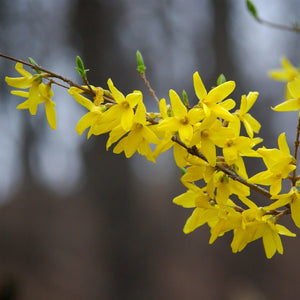The Forsythia Guide
Forsythia is a deciduous flowering shrub best known for its brilliant yellow flowers that emerge in early spring, often before any other plant in the landscape has begun to leaf out. With a fast growth rate and an arching, fountain-like habit, forsythia is a favorite among gardeners looking for bold seasonal color, ease of care, and versatile functionality. Its blooms provide one of the earliest nectar sources for pollinators, and its adaptability makes it a workhorse shrub in a wide range of residential and commercial landscape settings.
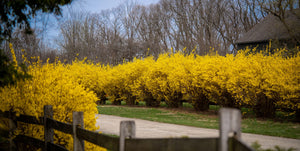
About
The Forsythia genus consists of approximately eleven species, with most modern landscape selections derived from hybrids within Forsythia x intermedia, a cross between Forsythia suspensa and Forsythia viridissima. This hybrid group includes many popular cultivars such as ‘Lynwood Gold’, prized for its upright form and profuse flowering; ‘Northern Gold’, noted for its superior cold hardiness; and ‘Weekend’, which offers a tidy growth habit with reliable early spring color.
Compact cultivars like ‘Show Off’ and ‘Courtasol’ were bred for smaller spaces, offering the same bright spring display on shorter, denser frames. Forsythia suspensa, the weeping forsythia, features long, trailing branches and is sometimes grown against walls or on slopes for a more informal, cascading effect.
Forsythias are deciduous, dropping their leaves in fall after a season of green foliage that transitions to yellow or purple tones depending on the variety. While their flowering period is brief—typically 1 to 3 weeks depending on weather—they are among the earliest bloomers and often serve as seasonal markers of spring’s arrival.
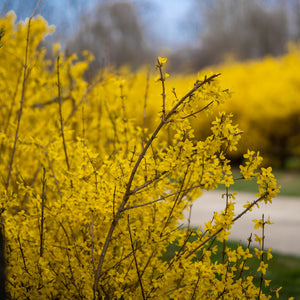
PLANTING
Forsythia is a tough, forgiving plant, but optimal performance requires thoughtful site selection and preparation.
USDA Hardiness Zones: Most varieties grow well in Zones 5–8. Cold-hardy cultivars like ‘Northern Gold’ can survive in Zone 4 with minimal winter damage.
Soil: Forsythia tolerates a wide range of soil types, including clay and sandy soils, but performs best in moderately fertile, well-drained soils. It does not like soggy conditions.
Sunlight: Full sun is preferred for the best flowering, with at least 6 hours of direct light daily. It will grow in partial shade, but flower production may be reduced.
Watering: Water young plants regularly to help establish roots. Once established, forsythia is fairly drought-tolerant, though it benefits from deep watering during extended dry periods.
Spacing: For a hedge or mass planting, space plants 4–6 feet apart depending on the variety. Compact selections like ‘Show Off’ may be spaced as close as 3 feet. Larger types like ‘Lynwood Gold’ may need 6–8 feet of space to reach their full potential.
Planting Time: Early spring or early fall is ideal, allowing roots to establish in mild weather before peak summer heat or winter cold.
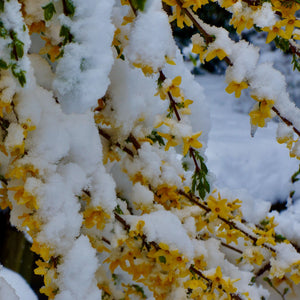
CARE
Forsythia is low-maintenance, but a little seasonal attention helps maintain its shape, vigor, and flower production.
Watering: Provide consistent moisture in the first year. After establishment, only water during prolonged droughts.
Fertilizing: Apply a balanced slow-release fertilizer in late winter or early spring to encourage flowering and healthy new growth. Avoid excessive nitrogen, which may promote foliage at the expense of blooms.
Pruning: Prune right after flowering ends in spring. Forsythia blooms on old wood, so pruning too late in the season removes next year’s flower buds. Remove up to one-third of the oldest stems at ground level annually to rejuvenate the shrub and maintain its arching habit. Thin crowded branches to improve airflow and reduce the risk of disease.
Pests & Diseases: Forsythia is generally pest- and disease-resistant. In overly wet conditions, root rot or crown gall may occur. Leaf spot can develop in humid environments but is rarely severe.
Mulching: Apply a 2–3 inch layer of organic mulch to help retain moisture and suppress weeds. Keep mulch a few inches away from the base of the plant to prevent rot.
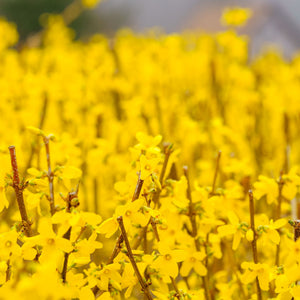
HOW TO USE
Forsythia’s bold spring presence and structural versatility make it a valuable addition to many landscape styles. Its adaptability allows it to shine in both formal and informal settings, while its early bloom season makes it an important visual and ecological component in multi-season garden designs.
Focal Point: In early spring, a mature forsythia in full bloom becomes an unmistakable focal point, drawing the eye with its golden floral display. Use it as a specimen shrub near entryways, driveways, or courtyard gardens to mark the change of season with dramatic color.
Hedges and Screens: Upright cultivars such as ‘Lynwood Gold’ and ‘Northern Gold’ work beautifully as informal hedges or privacy screens. Their fast growth and dense branching make them effective windbreaks and visual barriers, especially when planted in staggered rows.
Mass Plantings: For maximum seasonal impact, consider planting forsythia in groups of three or more. This works especially well in large open spaces, public gardens, or along property lines where a big splash of color is desired.
Erosion Control: Spreading types like Forsythia suspensa and compact growers like ‘Courtasol’ are excellent choices for slopes or banks, where their dense roots can help stabilize soil and reduce erosion.
Mixed Borders: Forsythia pairs well with other early spring bloomers such as Cornus mas (Cornelian cherry dogwood), Magnolia stellata, or Hamamelis (witch hazel), creating a layered display of color. Underplant with spring bulbs like daffodils and crocus to extend seasonal interest. As the forsythia's bloom fades, summer-flowering companions like Hydrangea arborescens, Spiraea japonica, and ornamental grasses can take over the spotlight.
Cottage and Wildlife Gardens: Forsythia’s early flowers are an important pollen source for emerging bees. Its arching branches provide habitat for small birds and pollinators when integrated into wildlife-friendly plantings.
Formal Applications: In more structured landscapes, compact cultivars such as ‘Show Off’ and ‘Courtasol’ can be used in rows along walkways or clipped lightly for shape control, offering color without taking up excess space.
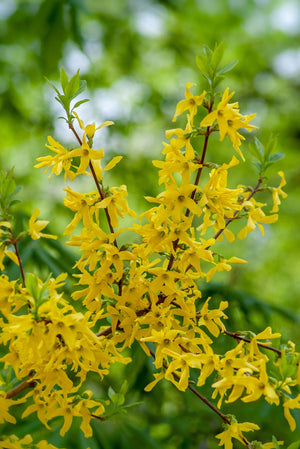
Common Questions
When to prune forsythia? The best time to prune forsythia is immediately after flowering, typically in mid to late spring. Pruning at this time allows the shrub to form flower buds for the following year.
How to prune forsythia? Remove up to one-third of the oldest stems at ground level to rejuvenate the plant. Also thin out any crowded or crossing branches and lightly shape the overall structure as needed. Avoid heavy summer or fall pruning, which removes next year’s bloom wood.
How to propagate forsythia? Forsythia is easy to propagate from cuttings or by layering. Take softwood cuttings in early summer or hardwood cuttings in late fall. Alternatively, pin a low branch to the ground and allow it to root before detaching it from the main plant.
When does forsythia bloom? Forsythia typically blooms in early spring, often in March or April depending on your region. In some areas, it can begin flowering as early as late February.
Do deer eat forsythia? Forsythia is considered deer-resistant. While deer may browse tender new growth under heavy pressure, it is generally not a preferred food source.
Is forsythia invasive? Forsythia is not officially classified as invasive in most regions, but it can spread aggressively by suckering or rooting where branches touch the ground. Regular pruning and containment measures can keep its growth in check.
Conclusion
Forsythia is a dependable, low-maintenance shrub that brings unmatched early-season color to gardens of all types. Whether used as a hedge, slope stabilizer, or springtime focal point, forsythia provides structure, brightness, and adaptability. With thoughtful pruning and companion planting, this spring herald can become a cornerstone of a multi-season, ecologically vibrant landscape.
The Forsythia Collection
Sold Out
Sold Out
Sold Out
Sold Out
Sold Out

